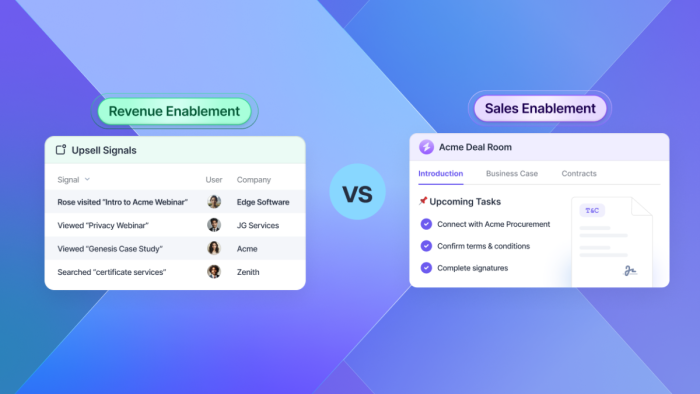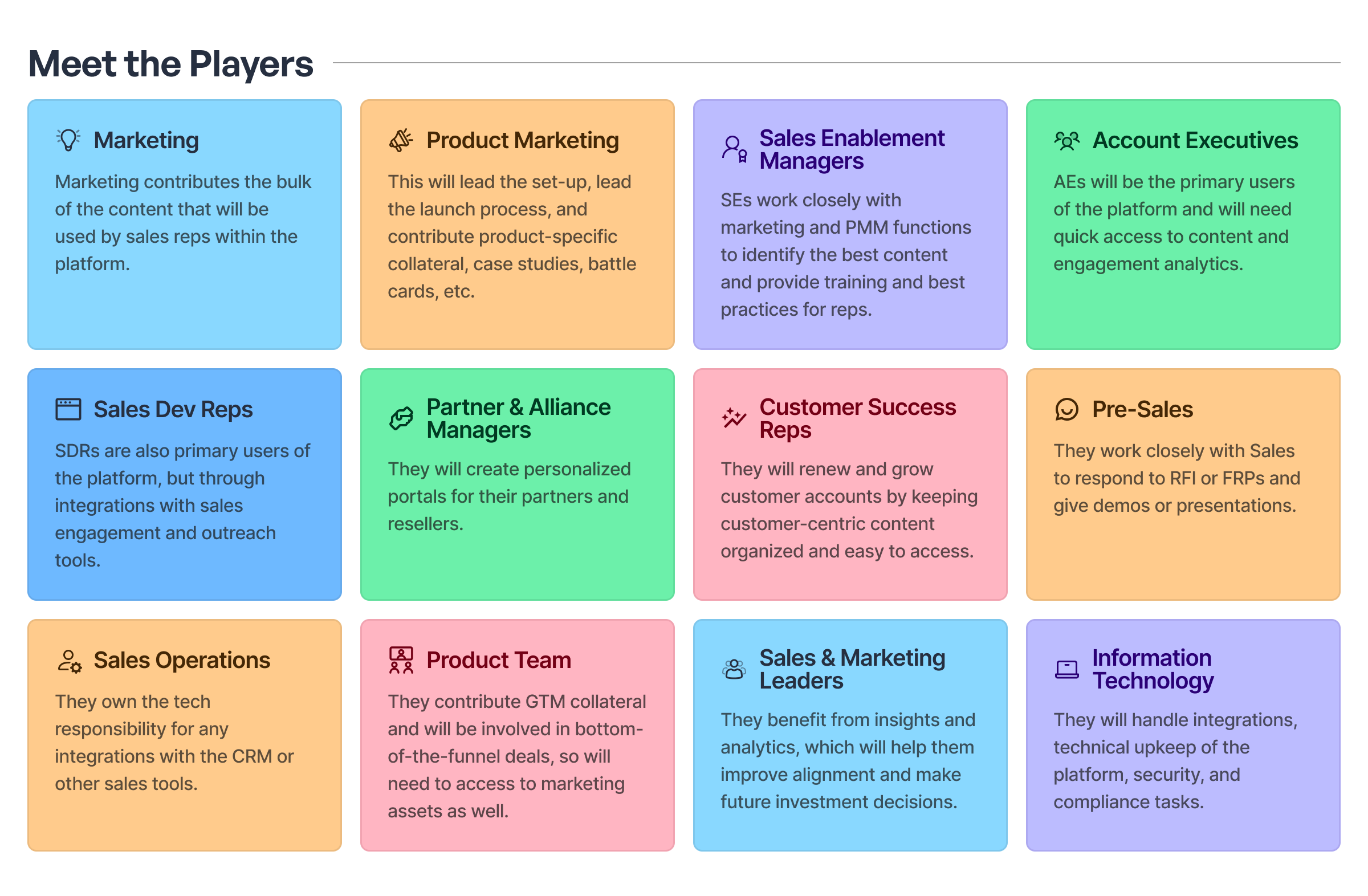What’s The Difference? Revenue Enablement vs Sales Enablement


Recently, B2B organizations have started calling standard sales enablement approaches by a new name: revenue enablement. Many are seeing revenue enablement as a cure-all that will help address stale enablement patterns that haven’t been working. Gartner has gone so far as to say that revenue enablement is “the solution to keeping up with changing buying habits.”
But revenue enablement and sales enablement are not the same thing. In this article, we break down what each term represents and how they’re distinct from each other to help you decide which approach will best work for you.
Read the article below, or click here to download the complete guide!
While Sales Enablement focuses on enabling the sales team to generate new revenue, Revenue Enablement takes a broader approach, aiming to allow all revenue-facing teams to not only acquire new revenue but also increase existing revenue.
What is Sales Enablement?
If you’re here, you likely have an idea of what sales enablement is. At its core, sales enablement is ensuring that the sales team has the tools to be successful. Check out how some of our friends across the industry define it:
Sales enablement is the iterative process of providing your business’s sales team with the resources they need to close more deals. These resources may include content, tools, knowledge, and information to sell your product or service to customers effectively.
Sales enablement is the process of providing the sales organization with the information, content and tools that help salespeople sell more effectively.
Sales enablement utilizes content, coaching, training, and technology to help reps onboard, enhance their skills, and increase sales. Sales enablement leaders care about increasing productivity, making a measurable business impact, and getting training programs out the door faster.
The key thing to note here is that every definition focuses on the sales team generating new revenue and acquiring new logos. Whether through training, tooling, or sales and marketing alignment, the overall objective is to arm sales with what they need to sell more.
What is Revenue Enablement?
Revenue enablement takes the same objectives of sales enablement, but zooms out to apply them to all revenue-facing teams.
Rather than focusing solely on sales and marketing, revenue enablement aims to bring all revenue-facing teams (Sales, Marketing, PMM, SE, Customer Success, Partnerships, Pre-Sales, etc.) together to work towards a unified goal of increasing revenue.
To Gartner’s point above, Revenue Enablement sprung out of a need to tear down silos that were forming between certain parts of the rev organization. Focusing too myopically on enabling the sales team has the potential to sideline the customer success or partnership teams, for example, which forces them to develop their tools, create their training, and act independently of the sales organization.
In our recent Revenue Enablement Platform Implementation Guide, we broke down the 12 teams that can potentially be involved in a revenue enablement program:

Sales Enablement vs Revenue Enablement
Oftentimes, the difference between the two methods simply boils down to scaling best practices across different teams. To best detail how sales enablement is different from revenue enablement, let’s break down a few everyday use cases:
Enablement Use Case #1: Create Customer Experiences
Sales Enablement Approach: Sales reps engage with prospects in a more personalized manner by sending them content and tracking their engagement. They serve buyers with tailored experiences, using sales deal rooms and microsites, and track buyer engagement. They can map this engagement through the buyer’s journey and use these insights to influence the sales opportunity. Sales teams can map out the entire buyer’s journey, combining outbound sales, marketing, and inbound sales, which ultimately leads to a deal’s closure.
Revenue Enablement Approach: Internally, it makes sense to have a single content library that supports the entire customer journey. However, with the broader scope of revenue enablement that expands beyond prospective buyers and includes existing customers, the sales enablement approach of sending targeted deal rooms is not scalable for existing customers. Yes, organizations can use deal rooms when working on renewals. But that's too opportunistic and doesn't help enable customers at scale. Companies need to invest in customer-tailored (as opposed to buyer-tailored) digital experiences like:
Onboarding Plans
Customer Training Portals
Customer Support Portals
Preferably, a single Customer Portal that encompasses all customer enablement needs.
The unified analytics of a revenue enablement platform track the various touchpoints a customer goes through, from being a prospect to becoming a customer.
Enablement Use Case 2: Revenue Content Library
Sales Enablement Approach: Sales and Marketing stakeholders maintain a single source of truth, allowing sales reps to find the right content at the right time. Furthermore, they integrate with CRM systems to provide reps with the correct information at the right time, within the context of the deal cycle. In addition to sharing content with prospects, enablement teams also use this content to onboard and train new and existing sales reps.
Revenue Enablement Approach: While Revenue Enablement is similar to Sales Enablement, it requires maintaining a single content library for all revenue teams. However, it is essential to personalize the experience for different revenue groups. For instance, the needs of Customer Success and Account Managers are different than those of Account Executives who are responsible for bringing in new logos. Similarly, teams that are working with partners and resellers have different enablement needs. Having one single content library delivers key advantages of:
Addresses redundancy of content
Enables a single source of truth for all revenue teams
Reduces the overall cost of enablement
However, to drive adoption and engagement, it is essential that enablement stakeholders can,
Personalize the experience for the different revenue teams
Give governance and content autonomy to varying groups without stepping on each other's toes
Support integrations for all teams. Not just for new logo sales
Enablement Use Case 3: Making Sales Content Readily Available to Channel and Partner Sellers
Sales Enablement Approach: Although the partner team is aligned with the sales team internally, they purchase a separate partner portal software for any partner management or content needs. Partners either log into these portals to find relevant content or receive a newsletter-style update on what’s new from the company.
Revenue Enablement Approach: Partners are granted access to the same enablement assets as internal selling teams, but with various built-in filters that prevent them from accessing or sharing any information they don’t have permission to see. All partner interactions, from how they log in to the platform to the assets they search for and share, become data points for both internal partner teams and content marketing teams. These content metrics can become KPIS for partner enablement managers or be passed down to marketing to influence the types of assets created for different partners.
In addition, communication between internal sales teams and partners remains fluid. Partners can leave feedback on content and training, and internal teams can view and respond accordingly.
What's Right For You?
To be clear, this isn’t a case of sales enablement versus revenue enablement, with one being better than the other. These are simply different methodologies that have arisen over time to address the needs of growing businesses.
But which one is right for you? The better question is “Which one should you start with?”
Signs that your organization should first invest in sales enablement:
You’re a smaller organization of <50 total revenue facing members
Your sales team is complaining that they can’t easily find content, and it’s slowing down their ability to close deals
You have relatively fast sales cycles (less than 30 days) and haven’t experienced any friction in aligning sales metrics with customer success.
For many companies, the major hurdle to success is consistently generating revenue from new customers. These organizations are usually smaller and are trying to nimbly respond to the needs of the sales team by connecting them with the resources or training they need. For these teams, sales enablement is a crucial first step, and success can be measured by rep confidence, asset utilization, and the time it takes for sales reps to onboard.
However, focusing on enabling only a new-logo sales team can run the risk of creating a “revenue silos”, resulting in each team developing its own set of best practices for groups of people that, in reality, should be aligned. You should be ready to expand the use of sales enablement investment to other revenue teams to avoid these drawbacks.
Signs that your organization should start with Revenue enablement:
All of your revenue-facing teams need access to the same set of documents, training sessions, and branding materials
Enabling your customers is as important as allowing your prospects and buyers. Customer retention is essential. It becomes more critical when organizations reach a specific revenue scale and have opportunities for cross-selling and upselling. Enabling your existing customer base is crucial for driving revenue growth.
The hand-offs between Sales and Customer Success are rocky, or expectations between the teams on where and how customers will start are being missed.
Customer engagement and customer communication are vital and you want to scale your sales enablement efforts beyond the buying stage of the customer journey.
An easy way to tell which methodology you should focus on is to zero in on the specific problems you are having:
Are sales not able to execute to their potential given the resources they have? Sales enablement.
Is the organization facing a retention problem and unable to grow its revenue share with existing customers? Sales enablement.
Further Reading
We hope this guide helped you understand the different methods of scaling revenue and which is right for you.
If you’re considering implementing a revenue enablement platform, check out our revenue enablement implementation guide.
Our guide to sales enablement insights can help you understand what a sales enablement platform can educate you about your team.
Our integrations deep dive goes deep into how these tools should interact with the rest of the tech stack.
FAQ
How does Marketing’s role change in a shift from sales to revenue enablement?
The most considerable change is that the revenue enablement approach will highlight the importance of customer marketing. The idea here is that marketing doesn't stop once someone is no longer a prospect; you're continuously marketing to them throughout the buyer and user life cycle.
By having CS use a revenue enablement platform to share training and onboarding materials with new customers or for customers up for renewal and expansion, it emphasizes staying in front of the buyer throughout their experience with the brand, which can help marketing embrace and take responsibility for that amount of revenue that they're helping grow.
Do you measure revenue enablement differently from sales enablement?
The short answer is yes.
For more details, let’s focus on the goals that an organization might set for each initiative. For a sales enablement initiative, a good goal can be as simple as “Are you enabling the sales team?”. Deal velocity, win percentage, and time to close a deal should also be impacted within 3-6 months of starting the team, as well as internal metrics. Sales confidence, whether measured formally through surveys or informally through conversations, should be going up. Onboarding time for new reps could potentially go down, but again, you’re mostly going to be measuring the sales team.
Revenue Enablement is going to force a team to take a broader look at how revenue is being affected. Sure, things like deal velocity should increase, but net revenue retention (driven by upsells and cross-sells), customer satisfaction, and partner-qualified revenue will also be equally important.
These goals may be bigger and hairier - for instance, how do you measure brand advocacy? It may be different for every company, but that's where scalability, profitability, and reliability come into play, especially during economic downturns, to create a stable business.
Where does content Enablement live?
While we’ve written about content enablement in the past and focused a lot of this article on those use cases, it is a part of both sales and revenue enablement.
Refresher: Content enablement is the practice of making everything you create, both internally and externally, more effective for your teams. Whether it’s suggesting training materials to prepare for a deal or finding the right fact sheet for a feature that the prospect might be interested in, it’s just enabling the assets you’re already creating to be more widely used by the team.
Content enablement has a home in both methodologies. For instance, content enablement can play a significant role in a sales enablement initiative by ensuring that sales reps are armed with the “right content at the right time” - but it can also do more.
Imagine that a Customer Success Manager puts together a large presentation featuring several new features for a client who is up for renewal in an attempt to upsell them to a larger package. In many organizations, that’s where the content ends - that file is locked away or potentially put on a shared drive for a team to use for another client in the future.
But that same presentation could also be helpful in the sales cycle, introducing similar buyers to that feature package and explaining its benefits to them. Opening up cross-team content collaboration and making assets more usable after they are created are examples of content + revenue enablement.
What Role Does Enablix play between revenue and sales enablement?
That’s the cool part - a single platform can enable both! Let’s talk about how.
Enablix can primarily serve as a sales enablement app for many teams. Our platform can speed up onboarding, reduce the time sales reps spend searching for content, and improve sales performance through better access and understanding of content.
However, we’re also built from the ground up to allow all your revenue-facing teams to work together. We’ve powered a complete customer enablement solution and a partner enablement solution, while also helping organizations respond to RFPS faster. Our content pages make collaboration between sales and customer support (CS) easier. At the same time, our analytics suite gives sales and marketing leaders a single view of how prospects interact with their brand.
If you’re interested in how a single platform can enable all your revenue-facing teams, let us know!